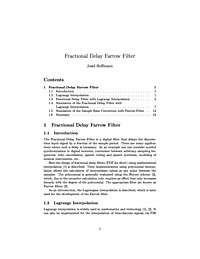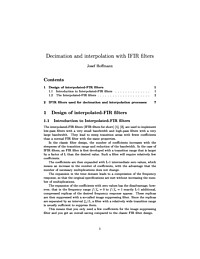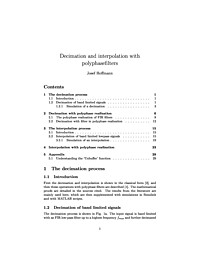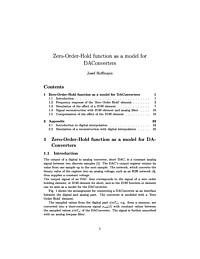Savitzky Golay Filter
The Savitzky-Golay filter is a mathematical smoothing filter that is often used in signal processing. It was first described in 1964 by Abraham Savitzky and Marcel Golay. The filter uses a polynomial regression over a series of values to find a smoothed value. One advantage of the Savitzky-Golay filter is that, unlike other smoothing filters, high-frequency components are not simply cut off, but are included in the calculation. As a result, the filter shows excellent properties with regard to the relative maxima, minima and scatter. In this article, the principle of the Savitzky Golay filter is explained and accompanied with MATLAB scripts. Two simple examples will be examined and provided with meaningful representations of the results to help understand these filters. The MATLAB function sgolay and its parameters are also explained and applied so that you can better understand this function and use it for your own applications.

Fractional Delay Farrow Filter
The Fractional Delay Farrow Filter is a digital filter that delays the discrete-time input signal by a fraction of the sample period. There are many applications where such a delay is necessary. As an example one can consider symbol synchronization in digital receivers, conversion between arbitrary sampling frequencies, echo cancellation, speech coding and speech synthesis, modeling of musical instruments, etc.

Decimation and Interpolation with IFIR Filters
In this article, the principle of the IFIR filter is first explained and accompanied by simulation. It also shows how to use the IFIR filters efficiently in the process of decimation and interpolation. Here, too, simulations with Simulink are used to explain the subject in an understandable manner.

Decimation and Interpolation with Polyphase Filters
This article deals with decimation and interpolation in classical and polyphase realizations. The topic is accompanied by many simulations with MATLAB and Simulink, so that the facts can be easily fixed. The simulations can be creatively expanded with your own ideas.

Zero-Order-Hold function as a model for DAConverters
The output of a digital to analog converter, short DAC, is a constant analog signal between two discrete samples. The DAC's output register retains its value from one sample up to the next sample. The network, which converts the binary value of the register into an analog voltage thus supplies a constant voltage and that leads to a stepped output signal. The analog smoothing filter connected at the output together with the frequency response of the DAC, modeled with a Zero-Order-Hold function, results in distortions. These are examined here and solutions to compensate for them are presented.

Decimation and Interpolation with Polyphase Filters
This article deals with decimation and interpolation in classical and polyphase realizations. The topic is accompanied by many simulations with MATLAB and Simulink, so that the facts can be easily fixed. The simulations can be creatively expanded with your own ideas.

Decimation and Interpolation with IFIR Filters
In this article, the principle of the IFIR filter is first explained and accompanied by simulation. It also shows how to use the IFIR filters efficiently in the process of decimation and interpolation. Here, too, simulations with Simulink are used to explain the subject in an understandable manner.
Savitzky Golay Filter
The Savitzky-Golay filter is a mathematical smoothing filter that is often used in signal processing. It was first described in 1964 by Abraham Savitzky and Marcel Golay. The filter uses a polynomial regression over a series of values to find a smoothed value. One advantage of the Savitzky-Golay filter is that, unlike other smoothing filters, high-frequency components are not simply cut off, but are included in the calculation. As a result, the filter shows excellent properties with regard to the relative maxima, minima and scatter. In this article, the principle of the Savitzky Golay filter is explained and accompanied with MATLAB scripts. Two simple examples will be examined and provided with meaningful representations of the results to help understand these filters. The MATLAB function sgolay and its parameters are also explained and applied so that you can better understand this function and use it for your own applications.

Fractional Delay Farrow Filter
The Fractional Delay Farrow Filter is a digital filter that delays the discrete-time input signal by a fraction of the sample period. There are many applications where such a delay is necessary. As an example one can consider symbol synchronization in digital receivers, conversion between arbitrary sampling frequencies, echo cancellation, speech coding and speech synthesis, modeling of musical instruments, etc.

Zero-Order-Hold function as a model for DAConverters
The output of a digital to analog converter, short DAC, is a constant analog signal between two discrete samples. The DAC's output register retains its value from one sample up to the next sample. The network, which converts the binary value of the register into an analog voltage thus supplies a constant voltage and that leads to a stepped output signal. The analog smoothing filter connected at the output together with the frequency response of the DAC, modeled with a Zero-Order-Hold function, results in distortions. These are examined here and solutions to compensate for them are presented.



















